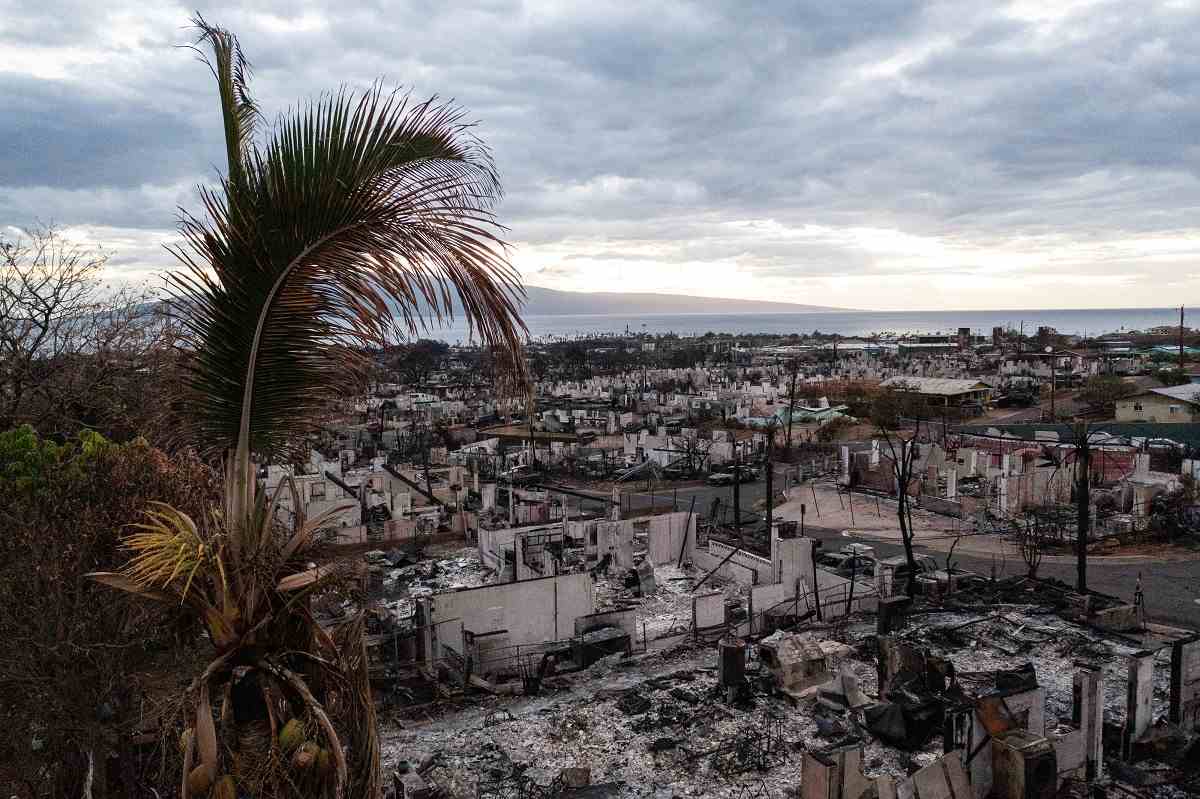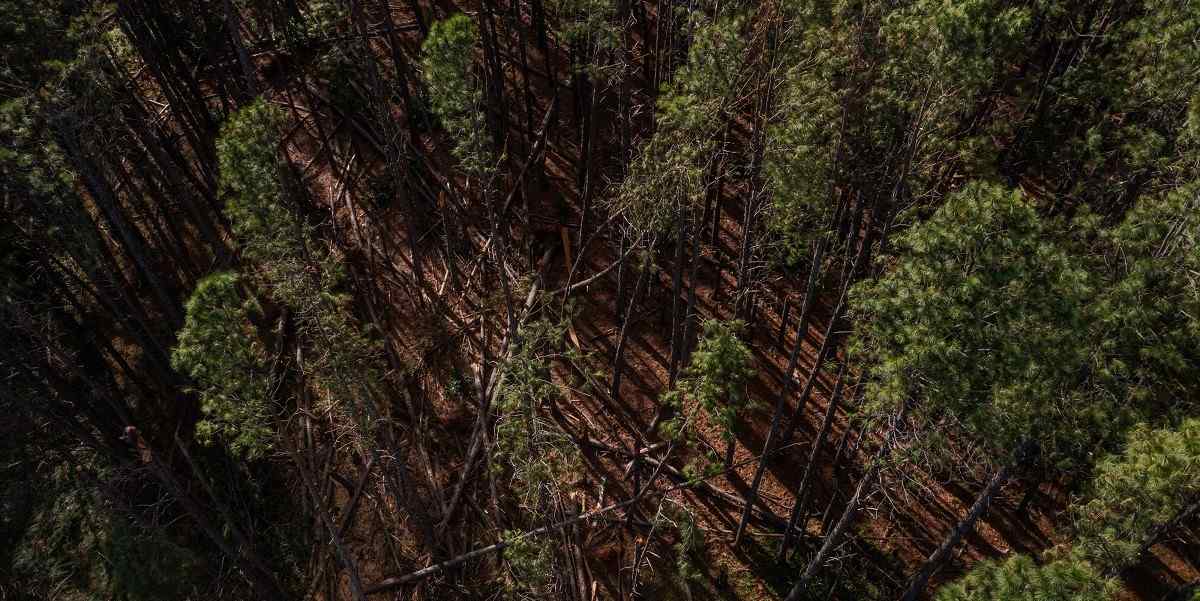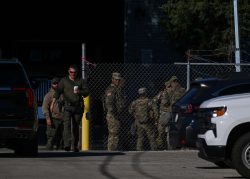
Burned homes and vehicles in a neighborhood that was destroyed by the wildfire in Lahaina, Hawaii, last month
16:05 JST, September 4, 2023
At her home in Waianae, a small town that hugs Oahu’s picturesque west coast, Samantha DeCorte worries that her family is living on a ticking fire bomb. “We’re on one of the driest spots on the island,” she said, an area awash in the same types of dried vegetation that helped transform the Maui wildfire into a raging monster that destroyed Lahaina.
“Not a lot of wind comes through,” said DeCorte, a 43-year-old mother of three, “but when it does it can pick up at the snap of a finger just like at Lahaina.” And yet, she is unaware of a county or state evacuation plan for her community and hasn’t heard of a rescue plan for residents in case the worst happens. “It’s definitely a concern because we were never faced with something like this before.”
Across the chain of Hawaiian islands – notably the larger, more populated islands of Hawaii and Oahu – many residents are grieving and fearing that a West Maui disaster could strike their communities. As of Friday in Lahaina, at least 115 people had been confirmed dead, with 385 missing and more than 2,000 structures destroyed. Damage projections were as high as $6 billion.
Hawaiians are on edge because the conditions that fueled the fast-moving inferno are all around them. Their islands are plagued by sprawling fallow fields – a legacy of the plantation era that endured for decades until many farms and ranches abruptly closed at the end of the last century.
Tens of thousands of acres where sugar cane and pineapples once grew have become overgrown with invasive vegetation, such as fountain and guinea grasses that can ignite easily and burn for weeks. The state’s explosion of fire events, from 5,000 acres annually to 20,000 in recent decades, can likely be traced to plantations that altered the natural landscape, according to Clay Trauernicht, a University of Hawaii wildland fire specialist quoted by the Associated Press.
Native Hawaiians, who fought to reclaim lands that were taken after White businessmen plotted to dethrone Queen Lili’uokalani, also live in areas that are plagued with vegetation that fuels wildfires. Just south of DeCorte’s home are two of the state’s largest homesteads, land granted to residents with at least 50 percent Hawaiian blood.
The invasive grasses – brought in by ranchers looking for a supply of livestock foliage that could survive droughts – formed deep, flammable layers as they dried out in a seasonal cycle. Yet for decades Hawaii’s government has done little to reduce the thicket.
In a memorandum to state lawmakers eight months before the West Maui fires, Hawaii Gov. Josh Green (D) noted the risks posed by invasive vegetation.
But in a passage that now worries many Hawaiians, the memo said that the Department of Land and Natural Resources “has minimal resources to carry out this mandate of fire protection on the vast landscape that it manages despite existing and increasing risks to public health, safety, and the environment.”
Hawaii’s largest fire – the 2021 Mana Road Fire that burned 40,000 acres – was sparked by power tools that workers were using to build a fence around rangeland on the Big Island. Residents in the area said they relied on neighbors, private workers and others to provide equipment such as bulldozers to help firefighters battle the blaze.
In a statement to The Washington Post, the Hawaii Emergency Management Agency acknowledged that “the deadly recent fires have deepened anxiety about fire hazards across Hawai’i, especially with drought worsening during the lengthy summer dry season.” As in the past, the agency vowed to improve fire hazard removal, saying that “planners are beginning work to secure additional resources to cut and remove fire-prone vegetation, including invasive grasses.”
The agency is also awaiting the results of the Attorney General’s investigation into the Maui fire, the email statement said. “A key element of emergency management is adapting to meet changing hazards and their consequences, so we’re always looking for better ways to prevent harm,” said EMA Administrator James Barros.
Many Hawaiians question the response of state and county authorities to the West Maui fire. Emergency management officials were slow to alert residents even as the National Weather Service warned of “a serious fire threat” from strong wind gusts from a passing hurricane. Sirens that could have alerted the community to the danger never sounded, triggering a torrent of criticism against Maui’s emergency management chief, who resigned nine days after the fire.
Those lapses weigh heavily on Jeanne Cooper, who lives in Kohala by the Sea, on the Big Island of Hawaii. On the same day that Lahaina was engulfed, Cooper was forced to evacuate her house at 4:40 a.m. because of another wildfire.
Cooper raced to a nearby beach with two dogs and a cat, then waited for hours before emergency officials allowed her to return. But around 3 p.m., the fire came roaring back.
“Firefighters thought they had it under control,” said Cooper, 61. “We had very, very high winds. Gusty winds stronger than any hurricane I’ve experienced. The fire started jumping breaks. It jumped one too many times and they had to move the line back.”
Cooper, a volunteer for the state’s Firewise Community Recognition Program, knew why the fire was so aggressive. “Nonnative grasses were a primary fuel of the Lahaina fire and we’re surrounded by that,” she said. “We’re freaked out by the amount of grass we have. I’ve never seen so much concern about fire expressed in our neighborhood.”
The rising fear has kept Mike Schorr busy. For the past six months, he has conducted home fire mitigation assessments as a volunteer for the Hawaii Wildfire Management Organization.
Before Lahaina, he conducted 12 assessments. In just two days afterward, “I received eight requests,” Schorr, 62, said. “I’m not chasing people, let me put it that way.
“The events in Lahaina brought in stark relief how quickly things can happen,” he said. “On the Big Island I can say communities here are quite concerned.”
Mark Thorne, a professor of rangeland ecology at the University of Hawaii at Mānoa, said the community seems to be viewing the threat more seriously than the government. He views the situation as so dire he has advocated for farming open fields to prevent dry vegetation from accumulating on them.
“There’s no management, there’s no crop production, there’s no livestock grazing,” he said. “All of this grass, biomass, it goes up, it dries out, it dies, it lays down, it goes back up again the next year.” That, he added, creates “a really dangerous situation” on the drier western slopes of the islands.
“Every place across the state is like this. This disaster could happen anywhere in the state on our leeward communities.”
What’s frightening, Thorne said, is that the state could allow the lessons of Lahaina to fade. “People kind of move on with their lives and they kind of forget about it until we get the next catastrophe,” he said.
DeCorte, a former Republican candidate for the state Senate, is urging residents to be more aware of their surroundings and will press officials to do more, partly because of the risks her community faces.
There is one way in and out of her Oahu neighborhood, which is framed by high cliffs. A tsunami evacuation in 2011 resulted traffic jam that took two and a half hours to travel five miles. “What would happen in those minutes I can’t even fathom,” she said. “They should get us at least an emergency access road. We’ve been trying to get that for decades.”
This week, Maui County officials visited Kihei, on the south side of the island, where Kalani Au-Hoon and other volunteers worked at a community distribution site for Lahaina victims. The officials asked what the workers needed, and Au-Hoon spoke up: Maui needs fire-safe construction that relies on fire-safe materials, not “matchbox tinder material,” he said.
He said Kihei “has been the desert for many years, and it catches fire every year.” Residents were evacuated around the time of the Lahaina fires and could breathe the smoke coming down from the Kula fires.
Au-Hoon, who was born in Oahu and grew up in South Maui, pointed to a nearby field that’s covered in dry, yellowing grasses. “Right here, one match. One ember, or something. And it’s toast,” he said.
Mike Munson, a Native Hawaiian who lives at the Pu’ukapu homestead on the Big Island, said he has nieces and nephews who lost homes in Lahaina and a sister in shock because people she knows are still missing.
Munson survived the 2021 Mana Road Fire that threatened hundreds of homes. It too was fueled by high winds and fed by invasive grasses. In a lawsuit, Native Hawaiian homesteaders said sparks from tools used to build a ranch fence started the blaze, scorching land they used to farm.
It might have been worse if the community had not acted to protect themselves, said Munson, 64. “We used all our resources. People reacted and they came up and supported us.”
The West Maui fire made residents elsewhere realize how fortunate they were, he said.
“This Lahaina event has really sparked a lot of people to make their home safe,” he added. It can happen to anyone.”

Fallen trees in a forest near Makawao, Hawaii, on Aug. 23.
"News Services" POPULAR ARTICLE
-

American Playwright Jeremy O. Harris Arrested in Japan on Alleged Drug Smuggling
-

Japan’s Nikkei Stock Average as JGB Yields, Yen Rise on Rate-Hike Bets
-

Japan’s Nikkei Stock Average Licks Wounds after Selloff Sparked by BOJ Hike Bets (UPDATE 1)
-

Japan’s Nikkei Stock Average Buoyed by Stable Yen; SoftBank’s Slide Caps Gains (UPDATE 1)
-

Japanese Bond Yields Zoom, Stocks Slide as Rate Hike Looms
JN ACCESS RANKING
-

Tokyo Economic Security Forum to Hold Inaugural Meeting Amid Tense Global Environment
-

Keidanren Chairman Yoshinobu Tsutsui Visits Kashiwazaki-Kariwa Nuclear Power Plant; Inspects New Emergency Safety System
-

Imports of Rare Earths from China Facing Delays, May Be Caused by Deterioration of Japan-China Relations
-

University of Tokyo Professor Discusses Japanese Economic Security in Interview Ahead of Forum
-

Japan Pulls out of Vietnam Nuclear Project, Complicating Hanoi’s Power Plans
























